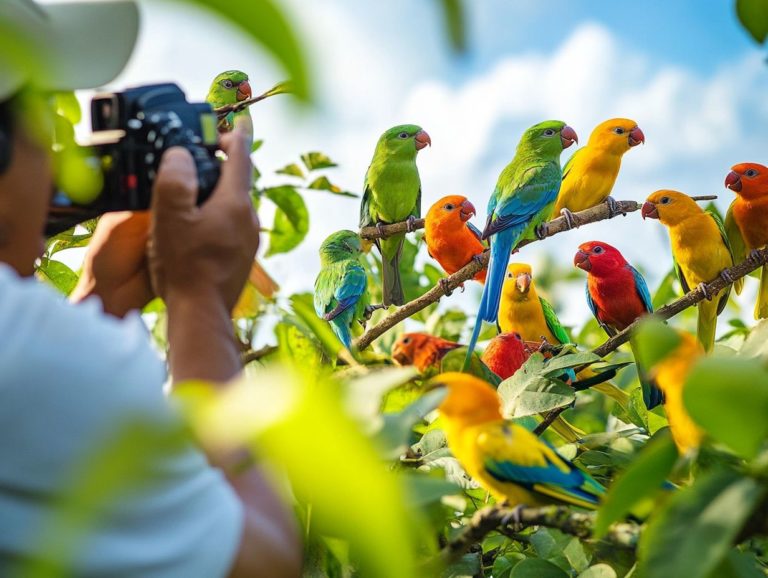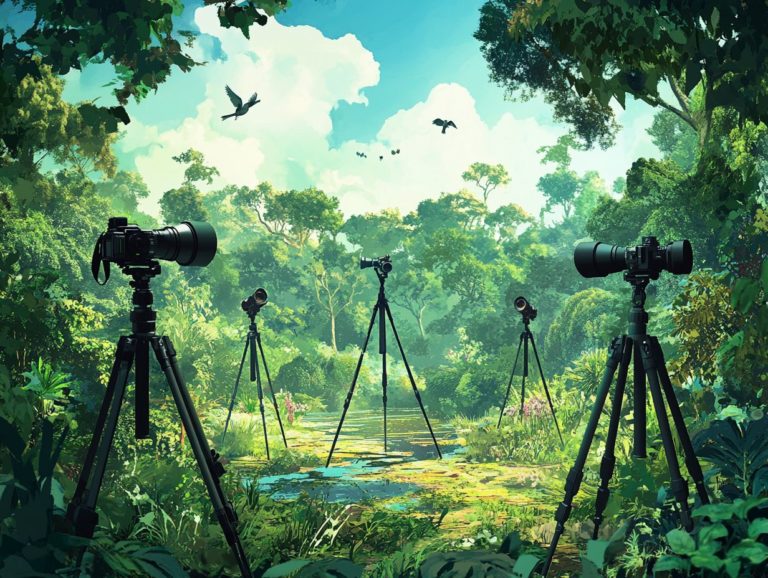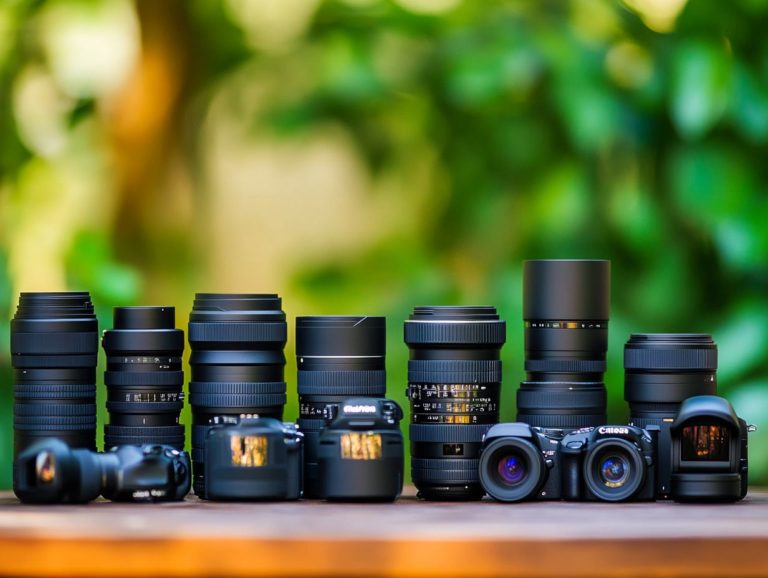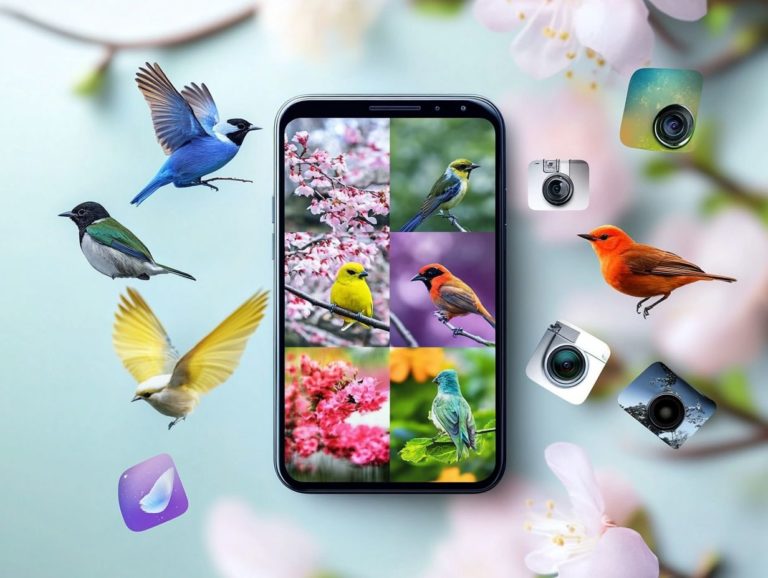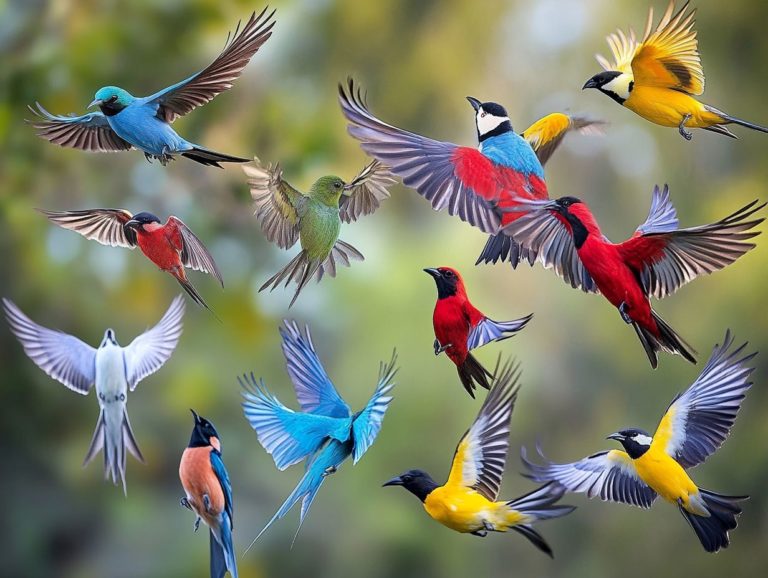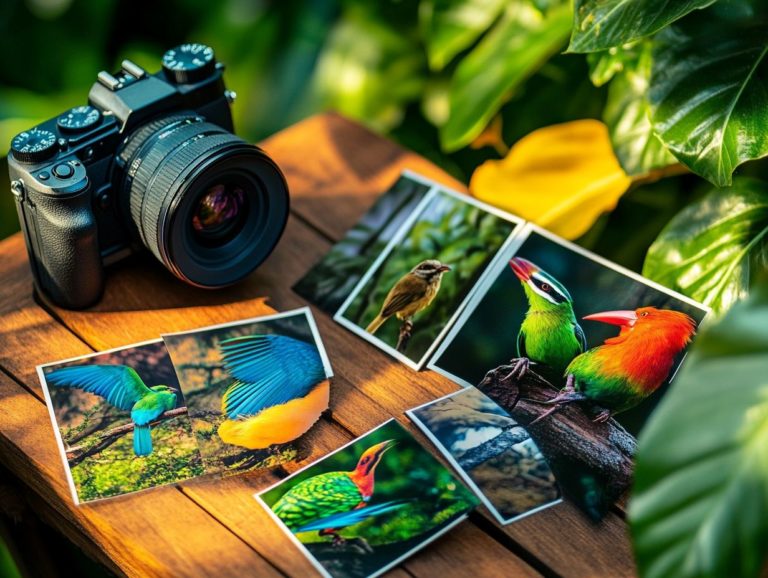Top 7 Teleconverters for Bird Shots
If you have a passion for wildlife photography, especially birding, a lens extender can truly transform your experience. A lens extender increases your camera’s zoom capability, allowing you to capture breathtaking close-ups of your avian subjects without the hassle of investing in a bulky, expensive long lens.
Get ready to discover the top seven lens extenders that can elevate your bird photography! This guide highlights their key features and offers best practices to ensure you maximize your gear s potential. Whether you re a seasoned professional or just beginning your journey, this guide will empower you to make informed decisions for those stunning shots you ve always wanted.
Contents
- Key Takeaways:
- 1. Nikon AF-S Teleconverter TC-14E III
- 2. Canon Extender EF 2x III
- 3. Tamron Teleconverter 1.4x
- 4. Sigma APO Teleconverter 2x EX DG
- 5. Sony FE 2.0x Teleconverter
- 6. Kenko Teleplus Pro 300 DGX 1.4x AF Teleconverter
- 7. Olympus MC-14 1.4x Teleconverter
- What Is a Teleconverter and How Does It Work?
- What Are the Key Features to Look for in a Teleconverter?
- How Do Teleconverters Affect Image Quality?
- What Are the Different Types of Teleconverters?
- How Can a Teleconverter Improve Bird Photography?
- What Are the Common Mistakes to Avoid When Using a Teleconverter?
- How Can a Teleconverter Be Used for Other Types of Photography?
- What Are the Best Practices for Maintaining a Teleconverter?
- Frequently Asked Questions
- 1. What are teleconverters and why are they useful for bird photography?
- 2. What are the top 7 teleconverters for bird shots?
- 3. How do I know which teleconverter is compatible with my camera and lens?
- 4. Are there any teleconverters that maintain autofocus and image quality?
- 5. Can I use multiple teleconverters at once?
- 6. Are there any drawbacks to using teleconverters for bird photography with a Canon 400mm lens?
Key Takeaways:
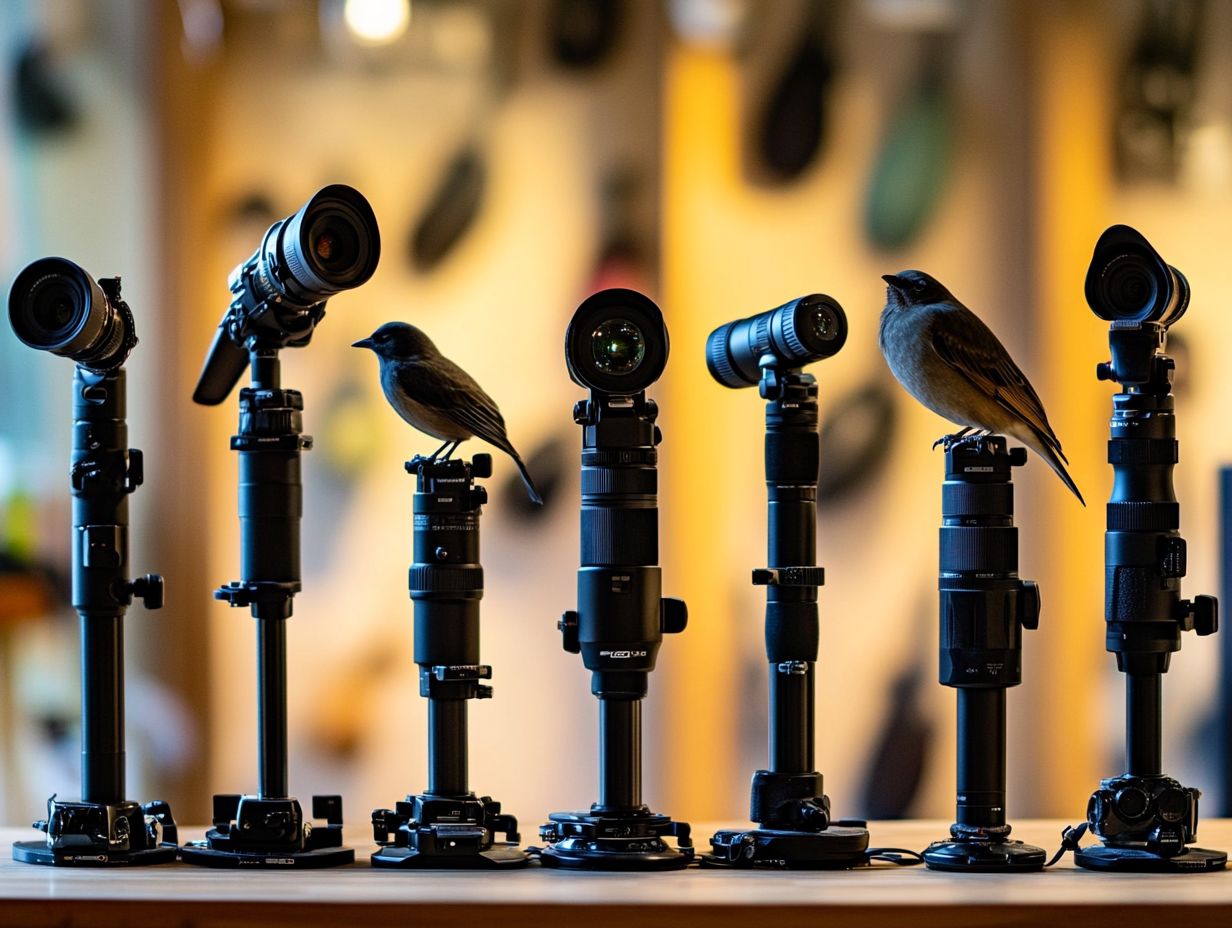
- The Nikon AF-S Teleconverter TC-14E III and Canon Extender EF 2x III are top picks for quality and versatility in bird photography.
- Lens extenders can improve reach and magnification, but careful selection and proper use are crucial for clear pictures.
- The Tamron 1.4x, Sigma 2x, Sony 2.0x, Kenko 1.4x, and Olympus MC-14 are also great options for bird shots, providing a range of compatibility and performance.
1. Nikon AF-S Teleconverter TC-14E III
The Nikon AF-S Teleconverter TC-14E III is a standout addition to your camera gear. It enhances the distance at which your lens can focus on compatible Nikon lenses. It s an ideal companion for wildlife photography enthusiasts aiming to capture sharp, stunning images of remarkable subjects like the majestic black bear along the Pacific coast.
This lens extender multiplies your focal length by 1.4x while ensuring clear pictures crucial for photographing elusive creatures in dim light. You ll appreciate the versatility it offers, as it works seamlessly with several Nikon lens models. This allows you to adapt to various shooting scenarios with ease. The TC-14E III excels in low-light conditions, delivering crisp details and vibrant colors. This makes it invaluable during those magical moments at dawn or dusk when wildlife is most active.
For those focused on capturing the beauty of wildlife, here are a few tips to elevate your photography game:
- Use faster shutter speeds to eliminate motion blur.
- Compose your shots with thoughtful framing to incorporate environmental context.
- Take advantage of the extended focal length for breathtaking visual storytelling.
2. Canon Extender EF 2x III
The Canon Extender EF 2x III is crafted for photographers like you who want to double the focal length of their Canon lenses. It’s especially favored by wildlife enthusiasts looking to capture sharp images of elusive creatures, from warblers flitting about to black bears lounging in their natural habitat.
This extender opens up new possibilities for capturing distant subjects in exquisite detail. Its compatibility with a variety of Canon lenses, including telephoto and super-telephoto options, enhances your versatility while ensuring that image quality remains top-notch.
When you’re photographing birds, for instance, maintaining a respectful distance is vital to avoid disturbing wildlife. The extender gives you the power to achieve captivating close-ups without encroaching on their space.
To make the most of this tool, it’s wise to experiment with your settings and stabilization techniques. This will help counteract any potential loss of light and sharpness, allowing you to maximize the extender’s performance even in challenging outdoor conditions.
3. Tamron Teleconverter 1.4x
The Tamron Teleconverter 1.4x is a fantastic option for you if you’re looking to elevate your photography game. It offers added focal length while ensuring that the image quality remains impressive, making it ideal for wildlife photography and environmental portraits.
This versatile accessory easily integrates with a variety of Tamron lenses, enabling you to extend your photographic reach without sacrificing clarity. With its design focused on minimizing chromatic aberrations and distortions, you can expect sharp images even when shooting at longer distances.
In low light conditions, increasing your ISO sensitivity which controls your camera’s sensitivity to light can work wonders. Pairing this with a sturdy tripod helps reduce camera shake, ensuring that every detail stays crisp and clear.
Whether you’re capturing the fleeting moments of wildlife or the subtle nuances of an environmental scene, using a slower shutter speed while stabilizing the lens can yield stunning shots that tell a captivating story.
4. Sigma APO Teleconverter 2x EX DG
The Sigma APO Teleconverter 2x EX DG is a remarkable accessory that gives you the power to extend the reach of your telephoto lenses. It is invaluable for capturing breathtaking wildlife moments while ensuring top-notch image quality.
This teleconverter effortlessly integrates with Sigma lenses, offering you greater flexibility without compromising the clarity you desire. If you’re passionate about landscapes or sporting events, this tool will be particularly advantageous, allowing you to frame distant subjects with remarkable sharpness.
Although it effectively doubles your focal length, it does come with challenges, such as reduced light intake and potential focus issues. To overcome these hurdles, consider using wider apertures when possible. This enables faster shutter speeds to minimize motion blur and optimize your results across various lighting conditions. Incorporate techniques like image stabilization to enhance your shooting experience.
5. Sony FE 2.0x Teleconverter
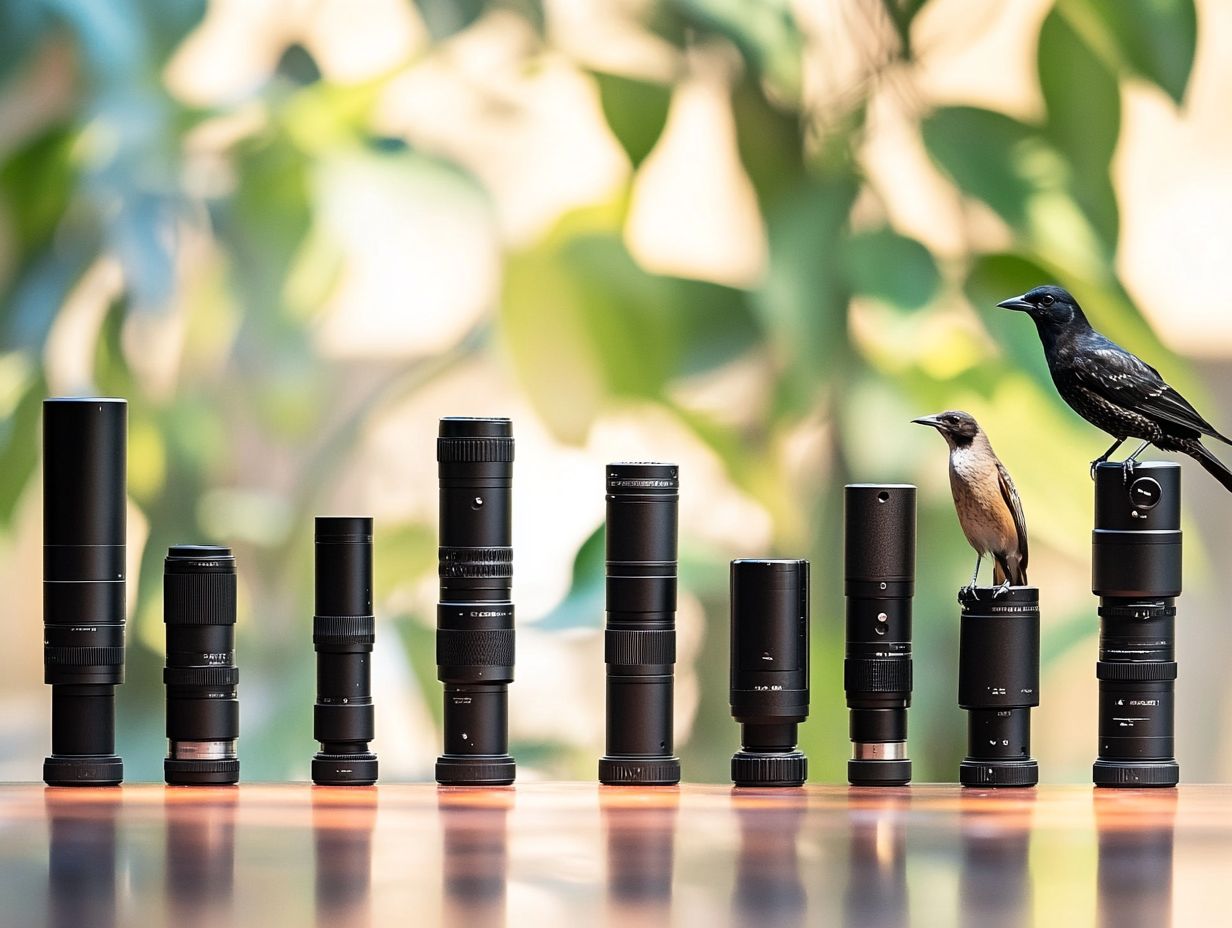
The Sony FE 2.0x Teleconverter is designed to amplify the focal length of compatible Sony lenses. It is a critical asset for photographers who demand precision in autofocus and high-quality images, especially when capturing wildlife.
This teleconverter integrates effortlessly with Sony’s advanced camera systems, enhancing autofocus speed and accuracy even at longer focal lengths. It broadens the versatility of your lenses during outdoor photography, enabling you to focus on capturing breathtaking images in various lighting conditions.
To ensure you achieve sharp images, consider implementing these techniques:
- Utilize a tripod for stability in your shots.
- Apply faster shutter speeds to minimize motion blur.
- Adjust ISO settings to accommodate changing light levels.
Capture stunning images of wildlife like never before! By paying careful attention to these strategies, the teleconverter becomes invaluable, allowing you to immortalize fleeting wildlife moments with exceptional clarity.
6. Kenko Teleplus Pro 300 DGX 1.4x AF Teleconverter
The Kenko Teleplus Pro 300 DGX 1.4x AF Teleconverter is an exceptional addition to your photography toolkit. It is designed to elevate your lens options. If you re aiming to create breathtaking wildlife photography, this teleconverter allows you to do so without sacrificing sharpness or quality.
Compatible with a broad array of lenses from top brands like Canon and Nikon, it s the perfect choice for those who have invested in premium glass. With this accessory, you can effortlessly extend your focal length while maintaining the unique characteristics of your original lenses.
For outdoor photography, mastering the use of this teleconverter requires a steady hand or, ideally, a tripod especially in low-light scenarios. Embracing patience and remaining quiet can significantly enhance your chances of capturing candid wildlife moments. After all, a little distance often results in unposed, authentic shots that beautifully reflect the wonders of nature.
7. Olympus MC-14 1.4x Teleconverter
The Olympus MC-14 1.4x Teleconverter is your compact and lightweight partner in crime. It allows you to extend the reach of your Olympus lenses while ensuring excellent image quality. This is perfect for outdoor wildlife photography adventures.
This innovative accessory maintains the image quality of your original lens. You can capture every detail of your subject with exceptional clarity. By effectively increasing the focal length, you can photograph animals from a respectful distance, minimizing disturbances to their natural behaviors.
The teleconverter integrates seamlessly with Olympus camera systems. It makes your photography experience smoother and more enjoyable by enabling faster autofocus and greater light transmission. This allows you to capture captivating shots even in challenging conditions. With such versatility, you can explore a broader range of creative possibilities without compromising quality.
What Is a Teleconverter and How Does It Work?
A teleconverter is an accessory you attach to your camera lens to boost its effective focal length. This enhancement provides greater flexibility in capturing distant subjects while preserving image quality. It s an essential component of your photography gear.
By multiplying your lens’s focal length, teleconverters help you frame subjects that might otherwise be out of reach for a standard lens. This expanded reach proves invaluable when photographing elusive wildlife, like birds or animals in their natural habitats, where distance often presents a challenge.
However, keep in mind that while the added magnification is tempting, it comes with certain trade-offs. Autofocus speed may suffer, especially in low-light conditions, which can result in missed opportunities. The effective narrowing of the aperture impacts performance in dim settings and reduces your depth of field.
Understanding these limitations is vital for achieving optimal results in your wildlife photography.
What Are the Key Features to Look for in a Teleconverter?
When selecting a teleconverter, focus on key features such as compatibility with your existing lens choices, impact on autofocus performance, and the overall image quality delivered. These are vital for your wildlife photography success.
Understanding magnification factors is crucial, as they can enhance or compromise the sharpness of your images. Pay attention to the number and quality of lens elements. This directly affects light transmission and distortion levels. For brands like Canon and Nikon, ensure that the teleconverter is specifically designed for your lens type for the best results.
To maximize performance, consider using a sturdy tripod to significantly reduce camera shake. Shooting during optimal lighting conditions also enhances clarity and contrast in your captured images.
How Do Teleconverters Affect Image Quality?
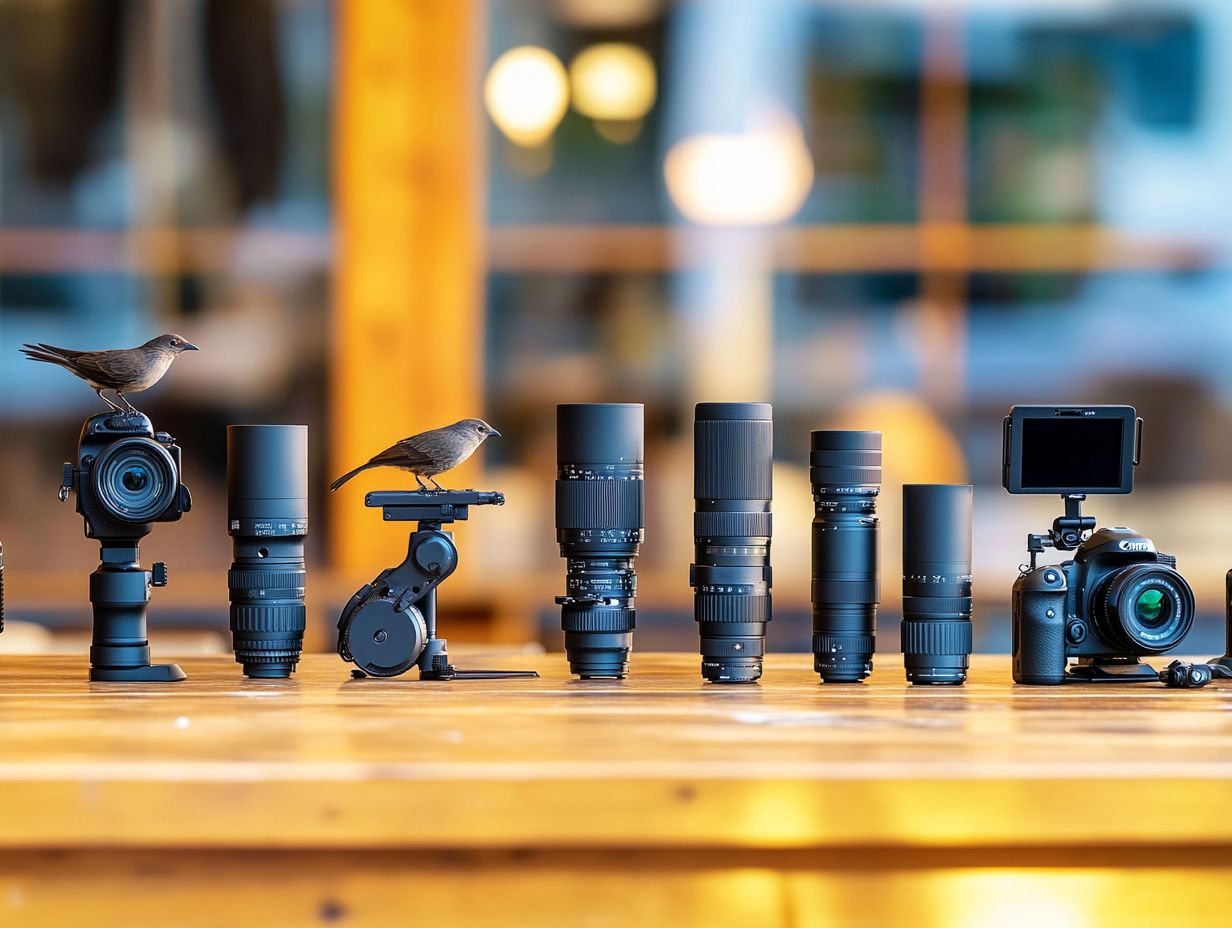
Teleconverters can significantly influence image quality, impacting sharpness, contrast, and overall clarity. It s crucial to understand your photographic limitations when using these accessories.
Recognizing these limitations means being aware of how factors like aperture considerations and lens compatibility come into play. Using a teleconverter effectively reduces the maximum aperture of your lens. This can lead to slower shutter speeds and an increased risk of camera shake. Not every lens works seamlessly with teleconverters; mismatched combinations can result in softer images or diminished contrast.
Seasoned photographers often share that hasty setups can yield less-than-ideal results. This underscores the necessity of testing and familiarizing yourself with your equipment. By doing so, you can achieve sharp, vivid results that truly reflect your vision.
Ready to elevate your wildlife photography? Explore the options available today!
What Are the Different Types of Teleconverters?
Teleconverters come in various types, such as 1.4X teleconverters and 2X extenders. Each offers distinct advantages and challenges for photographers aiming to elevate their lens capabilities for wildlife photography.
Understanding the differences between these options is crucial. Your choice can greatly influence image quality and performance. A 1.4X teleconverter strikes a commendable balance. It provides increased magnification while minimizing light loss and keeps images sharp. This is ideal for those utilizing fast prime lenses (lenses with a wide maximum aperture).
On the other hand, a 2X extender effectively doubles your focal length. However, it may result in a significant drop in aperture, affecting autofocus and overall brightness. Therefore, the suitability of these teleconverters hinges on the specific lens you pair them with.
Premium lenses featuring superior glass elements tend to work best. They deliver optimal performance and clarity in your wildlife photography endeavors.
How Can a Teleconverter Improve Bird Photography?
A teleconverter can significantly elevate your bird photography. It increases the effective focal length of your lens. This enhancement allows you to capture the unique behaviors of elusive birds while ensuring your autofocus remains responsive.
With the right approach, using a teleconverter can transform your photographic journey. It enables you to frame stunning images from impressive distances. It’s essential to choose a teleconverter that pairs seamlessly with your specific lens to maintain image quality, especially when working with longer focal lengths. For instance, 2X converters effectively double your reach.
Success in this field often comes down to techniques such as patience and stealth. By remaining unobtrusive while setting up, you’ll minimize disturbance to your feathered subjects. Use natural cover like trees and bushes to create an excellent vantage point. This approach allows you to capture breathtaking close-up shots without startling your avian friends.
What Are the Common Mistakes to Avoid When Using a Teleconverter?
Photographers frequently encounter pitfalls when utilizing a teleconverter. Common mistakes include miscalculating shooting distances or overlooking the effects on autofocus and image quality. These missteps can disrupt your photography workflow and lead to frustrating outcomes, especially in challenging conditions like low light.
Ensuring compatibility between your teleconverter and lenses is crucial. Otherwise, you risk an autofocus system that struggles or fails altogether. Always test your gear before a big shoot to ensure great results!
A practical tip to enhance your results is to use a tripod. This provides the stability needed to maximize the sharpness of your images. Even the slightest camera movement can yield disappointing results when working with extended focal lengths.
How Can a Teleconverter Be Used for Other Types of Photography?
Beyond wildlife photography, you ll find that a teleconverter can elevate your craft across various genres, including outdoor and macro photography. It grants you the creative freedom to explore a wider array of subjects.
Take outdoor photography, for example. When you employ a teleconverter, your landscapes can undergo a dramatic transformation. You can capture intimate compositions of distant mountain peaks or detailed glimpses of wildlife habitats. This enhancement amplifies distant subjects and adds remarkable depth to your landscape images.
In macro photography, the extra focal length provided by a teleconverter gives you the power to isolate intricate details in nature. For instance, you can focus on the iridescence of a butterfly’s wing or the delicate textures of a flower petal.
Try creative techniques like panning with a teleconverter for dynamic outdoor scenes. This approach can yield striking motion blur, creating a captivating contrast between movement and focus.
In summary, using a teleconverter can enhance your photography across various genres. By understanding their types and avoiding common mistakes, you can capture stunning images with greater ease.
Ready to enhance your photography? Grab a teleconverter and start capturing stunning images today!
What Are the Best Practices for Maintaining a Teleconverter?
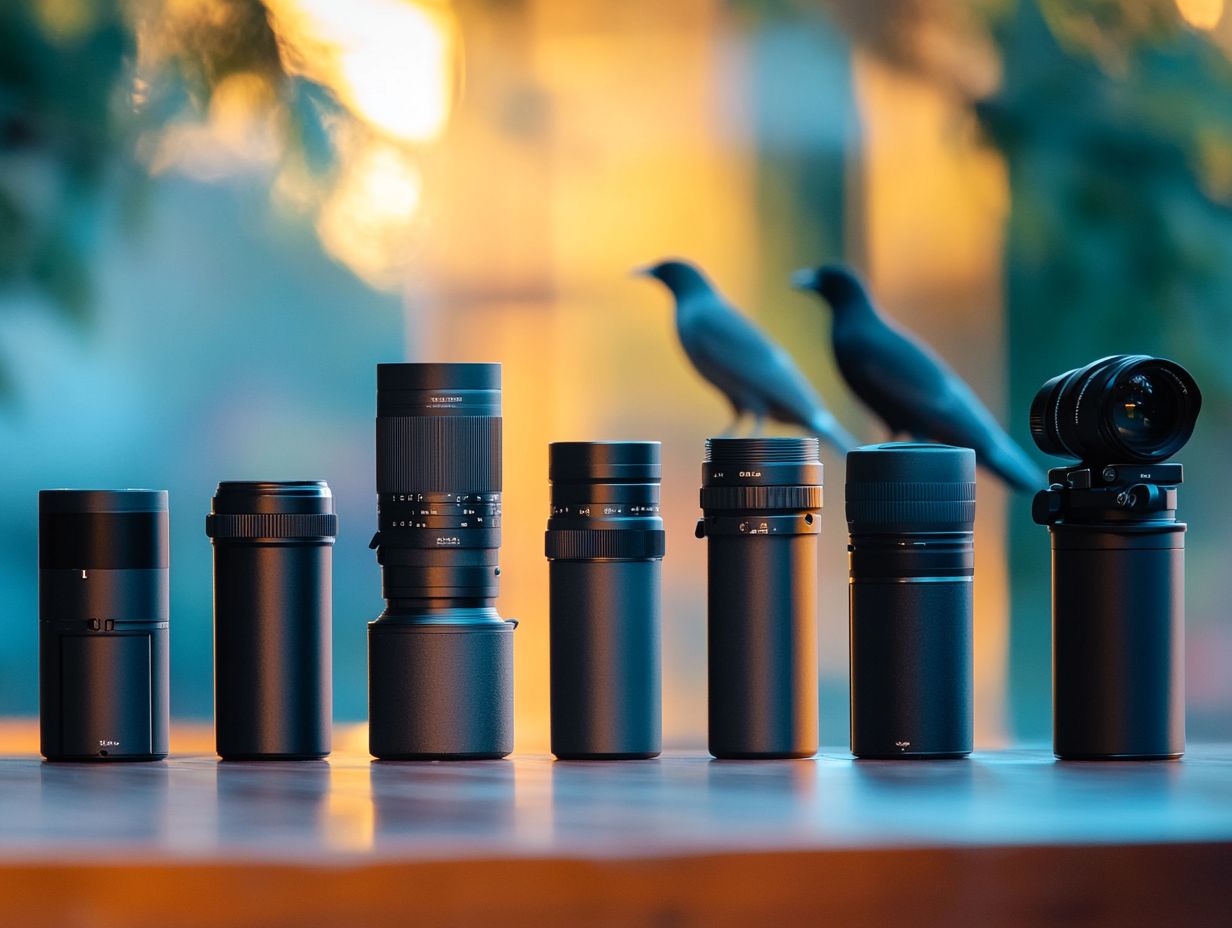
Maintaining your teleconverter is essential for best performance. It also ensures longevity. This involves simple yet effective practices that protect your valuable photography gear from dust and damage.
Regular cleaning is key. Using a soft microfiber cloth to wipe the exterior and keeping the glass elements smudge-free will help you preserve image clarity. When not in use, storing the teleconverter in a protective case will shield it from accidental impacts and environmental factors.
Before mounting, always check compatibility with your lenses. Manufacturers typically offer guidelines, and tapping into online forums or communities can provide helpful tips. Consistent maintenance not only enhances functionality but also plays a vital role in preserving image quality across various shooting conditions.
Frequently Asked Questions
1. What are teleconverters and why are they useful for bird photography?
Teleconverters are camera accessories that increase the focal length of your lens. This allows you to get closer to your subject without physically moving closer, making them ideal for capturing small and distant birds.
2. What are the top 7 teleconverters for bird shots?
The top 7 teleconverters for bird shots are the Canon Extender EF 1.4x III, Tamron SP AF 1.4x Pro Teleconverter, Sigma APO Teleconverter 1.4x EX DG, Nikon AF-S Teleconverter TC-14E III, Kenko Teleplus Pro 300 DGX 1.4x AF Teleconverter, Sony 1.4x Teleconverter, and Olympus MC-14 1.4x Teleconverter.
3. How do I know which teleconverter is compatible with my camera and lens?
Always check compatibility to ensure you get the perfect teleconverter for your needs! Make sure to match the brand of your teleconverter with your camera and lens brand. Additionally, check the maximum aperture the largest opening of the lens, which affects light intake as some teleconverters are only compatible with certain apertures.
4. Are there any teleconverters that maintain autofocus and image quality?
Absolutely! Many teleconverters maintain excellent autofocus and image quality, so you can capture stunning shots. The top 7 listed above have been known to maintain these features, but it is always best to do research and read reviews before making a purchase.
5. Can I use multiple teleconverters at once?
While it is possible to stack teleconverters, it is not recommended. Doing so can significantly decrease image quality and may even cause incompatibility issues between the teleconverters and your camera and lens.
6. Are there any drawbacks to using teleconverters for bird photography with a Canon 400mm lens?
Some potential drawbacks of using teleconverters for bird photography include decreased image quality and a loss of light, as teleconverters typically have a 1-stop or 2-stop light loss. Teleconverters may also slow down autofocus speed.

